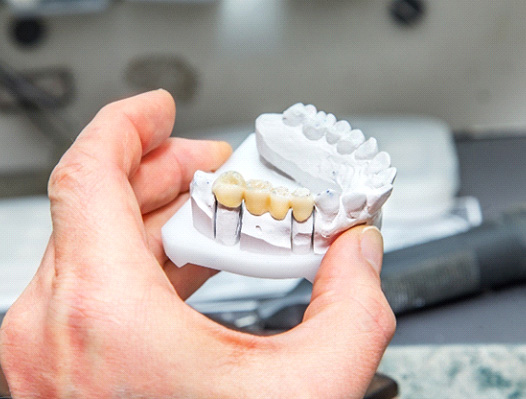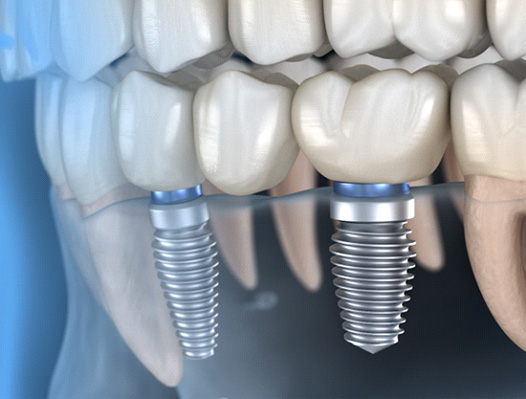Dental Bridges – DuPont, WA
Eliminating Space by Bridging the Gap

Unwanted space in your smile can cause you to struggle with some of the most basic functions, like eating and speaking. Not to mention, gaps where teeth once existed may cause you to feel self-conscious about your appearance. The good news is that with the help of DuPont Family Dentistry, our team can fill in the gaps in your smile using dental bridges in DuPont . Call us today to schedule an appointment with a member of our team to find out if you are a candidate for treatment.
What is a Dental Bridge?

A dental bridge is a customized prosthetic that fills in unwanted space within your smile. When two, three, or four teeth are extracted or missing, the lack of stimulation to the jawbone can cause it to deteriorate over time and even result in further tooth loss. However, with a dental bridge that consists of two dental crowns and artificial pontics (teeth), the gap can be filled in to create a sturdy, lifelike solution that allows for improved oral function.
Types of Dental Bridges

Scheduling a consultation with your dentist in DuPont is necessary before moving forward with any type of restorative treatment. When discussing your candidacy and current oral and overall health, you will learn there are two types of bridges to choose from:
Traditional Dental Bridge
Traditional bridges rely on healthy abutment teeth to remain in place. Crafted from the highest quality materials, they consist of two dental crowns that are placed over altered teeth that reside on either side of the gap. Connecting the two crowns are pontics (artificial teeth) that sit on top of the gums to “bridge the gap.” Once secured, the bridge allows for improved eating and speaking as well as greater confidence because of your complete smile.
Implant Bridge
Implant brides are different from the traditional kind in that these prosthetics are secured to the tops of dental implant posts. Made of titanium, these screw-like posts are surgically placed within the jawbone to create a stable foundation for your new smile. After 3-6 months of healing and allowing osseointegration to occur, which is the fusing of the bone and implant, a customized bridge is placed on top to fill in the gaps and restore oral function.
What Are the Benefits of Getting a Dental Bridge?

There are many benefits that come with dental bridges. Depending on which kind you choose, some advantages may appear greater than others:
- Improved jawbone stimulation (implant bridge)
- Prosthetic that will last 10 years or more (traditional bridge), or one that can remain in place for 30+ years (implant bridge)
- Greater aesthetics that allow you to look younger and feel more confident in your smile
- Dental drift is no longer a concern because of the customized prosthetic. This means your natural teeth will remain in place
Dental Bridge FAQs
How long should a dental bridge last?
The average lifespan of a dental bridge is between 5-15 years. This is ultimately determined by how well you take care of it over time. But it is also dependent on the type of material used to create your bridge. While it is true that there is a minor increase in lifespan for those made out of metal, the difference is often considered negligible. If you want your bridge to last as long as possible, it is important that you think about your diet, your lifestyle habits, and your commitment to good oral hygiene.
Bridges that are used to replace teeth toward the front of the mouth are known to last slightly longer than those placed toward the back. The reason is that they do not sustain the same level of wear and tear. But if you are living with an implant bridge, you can expect your restoration to last much longer than a traditional one. The average lifespan for an implant bridge is likely to be 30+ years!
How many teeth can a dental bridge replace?
It is important that you do not rely on a dental bridge to replace a multitude of missing teeth. Having a bridge that is too long often means less stability. Typically, a dentist in DuPont will recommend a bridge if you are missing between one and four teeth in a row, but the normal is one or two teeth.
If you receive an implant bridge, the risk of replacing three or four missing teeth lowers, as these are designed to be just as strong as regular teeth.
Do dental bridges look natural?
When meeting with your dentist to discuss your candidacy for dental bridges, you will discover many different materials can be used to create your restoration. Many dentists can create bridges out of ceramic, zirconia, and other metal-free solutions, as they can be color-matched to your natural tooth shade for a more blended look. Once put into place, the bridge will look like traditional tooth enamel because of the way the light bounces off them.
If you have a bridge that is made out of metal, it will not look natural, but if it is located in an area of the mouth that is not visible to others, you may not be too concerned about it. You can, however, talk to your dentist about the potential of swapping out your existing bridge for a newer, tooth-colored version.
How do I clean under my bridge?
Ensuring optimal oral hygiene while wearing a bridge is important. This is why we recommend that you do one or more of the following:
- Use dental floss to maneuver the area underneath the bridge, sliding it along the restoration to remove any bad oral bacteria.
- Use an interdental brush or interproximal brush to slide them in and out from underneath the bridge, as this will help to remove any food debris.
- Use a water flosser to push water underneath the bridge and eliminate any built-up debris and plaque that might try to accumulate throughout the day.
